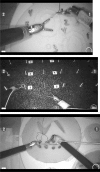Robotic surgical skills: acquisition, maintenance, and degradation
- PMID: 23477169
- PMCID: PMC3481234
- DOI: 10.4293/108680812x13427982376185
Robotic surgical skills: acquisition, maintenance, and degradation
Abstract
Background and objectives: The degradation in robotic skills that occurs during periods of robotic surgical inactivity in newly trained surgeons was measured. The role of animate training in robotic skill was also assessed.
Methods: Robotically naive resident and attending surgeons underwent training with the da Vinci robot on needle passage (DN), rocking ring transfer peg board (RPB), and running suture pod tasks (SP). Errors were established to convert actual time to adjusted time. Participants were deemed "proficient" once their adjusted times were within 80% of those set by experienced surgeons through repeated trials. Participants did not use the robot except for repeating the tasks once at 4, 8, and 12 weeks (tests). Participants then underwent animate training and completed a final test within 7 days.
Results: Twenty-five attending and 29 resident surgeons enrolled; 3 withdrew. There were significant increases in time to complete each of the tasks, and in errors, by 4 weeks (Adjusted times: DN: 122.9 +/- 2.2 to 204.2 +/- 11.7, t = 6.9, P < .001; RPB: 262.4 +/- 2.5 to 364.7 +/- 8.0, t = 12.4, P < .001; SP: 91.4 +/- 1.4 to 169.9 +/- 6.8, t = 11.3, P < .001). Times decreased following animate training, but not to levels observed after proficiency training for the RPB and SP modules.
Conclusions: Robotic surgical skills degrade significantly within 4 weeks of inactivity in newly trained surgeons. Animate training may provide different skills than those acquired in the dry lab.
Figures





Similar articles
-
Transferability of Virtual Reality, Simulation-Based, Robotic Suturing Skills to a Live Porcine Model in Novice Surgeons: A Single-Blind Randomized Controlled Trial.J Minim Invasive Gynecol. 2017 Mar-Apr;24(3):420-425. doi: 10.1016/j.jmig.2016.12.016. Epub 2016 Dec 24. J Minim Invasive Gynecol. 2017. PMID: 28027975 Clinical Trial.
-
Multidisciplinary validation study of the da Vinci Skills Simulator: educational tool and assessment device.J Robot Surg. 2013 Dec;7(4):365-9. doi: 10.1007/s11701-013-0403-6. Epub 2013 Apr 21. J Robot Surg. 2013. PMID: 27001876
-
Robotic virtual reality simulation plus standard robotic orientation versus standard robotic orientation alone: a randomized controlled trial.Female Pelvic Med Reconstr Surg. 2013 Sep-Oct;19(5):266-70. doi: 10.1097/SPV.0b013e3182a09101. Female Pelvic Med Reconstr Surg. 2013. PMID: 23982574 Clinical Trial.
-
Da Vinci© Skills Simulator™: is an early selection of talented console surgeons possible?J Robot Surg. 2016 Dec;10(4):289-296. doi: 10.1007/s11701-016-0616-6. Epub 2016 Jun 22. J Robot Surg. 2016. PMID: 27334771 Review.
-
Robotic Surgery: The Impact of Simulation and Other Innovative Platforms on Performance and Training.J Minim Invasive Gynecol. 2021 Mar;28(3):490-495. doi: 10.1016/j.jmig.2020.12.001. Epub 2020 Dec 10. J Minim Invasive Gynecol. 2021. PMID: 33310145 Review.
Cited by
-
Efficiency and Accuracy of Robotic Surgical Performance Decayed Among Urologists During COVID-19 Shutdown.J Endourol. 2021 Jun;35(6):888-890. doi: 10.1089/end.2020.0869. Epub 2020 Dec 11. J Endourol. 2021. PMID: 33191787 Free PMC article. No abstract available.
-
COVID 19 and Surgical Education: Time for Innovations.Indian J Surg. 2020 Jun;82(3):286-287. doi: 10.1007/s12262-020-02422-5. Epub 2020 Jun 1. Indian J Surg. 2020. PMID: 32837062 Free PMC article. No abstract available.
-
[Robot-assisted surgery - Progress or expensive toy? : Matched-pair comparative analysis of robot-assisted cholecystectomy vs. laparoscopic cholecystectomy].Chirurg. 2017 Dec;88(12):1040-1045. doi: 10.1007/s00104-017-0466-4. Chirurg. 2017. PMID: 28660327 German.
-
Can teenage novel users perform as well as General Surgery residents upon initial exposure to a robotic surgical system simulator?J Robot Surg. 2018 Mar;12(1):165-171. doi: 10.1007/s11701-017-0715-z. Epub 2017 Jun 5. J Robot Surg. 2018. PMID: 28585104
-
Virtual reality robotic surgery warm-up improves task performance in a dry laboratory environment: a prospective randomized controlled study.J Am Coll Surg. 2013 Jun;216(6):1181-92. doi: 10.1016/j.jamcollsurg.2013.02.012. Epub 2013 Apr 11. J Am Coll Surg. 2013. PMID: 23583618 Free PMC article. Clinical Trial.
References
-
- Intuitive Surgical Inc. Annual Report 2010; Sunnyvale, CA. 1 Feb 2011; < http://phx.corporate-ir.net/phoenix.zhtml?c=122359&p=irol-sec>.
-
- Paley PJ, Veljovich DS, Shah CA, et al. Surgical outcomes in gynecologic oncology in the era of robotics: analysis of first 1000 cases. Am J Obstet Gynecol. 2011;204(6):551.e. 1–9 Epub 2011 Mar 16 - PubMed
-
- Chen CC, Falcone T. Robotic gynecologic surgery: past, present, and future. Clin Obstet Gynecol. 2009. September;52(3):335–343 - PubMed
-
- Magrina JF, Kho RM, Weaver AL, Montero RP, Magtibay PM. Robotic radical hysterectomy: comparison with laparoscopy and laparotomy. Gynecol Oncol. 2008. April;109(1):86–91 - PubMed
Publication types
MeSH terms
LinkOut - more resources
Full Text Sources
Miscellaneous
